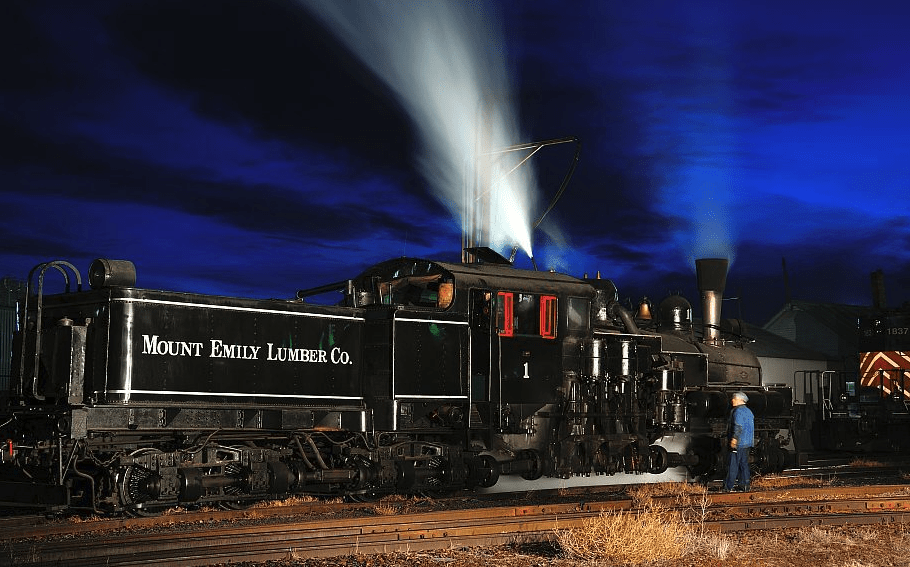A Union County icon set to be moved to Portland
Published 7:00 am Tuesday, September 20, 2022

- Mount Emily Shay No. 1, a steam-powered locomotive used for logging operations in Union County through the 1950s, prepares for a night excursion in the mid-2010s in Prineville. The historic locomotive in 2024 moved from Prineville to Portland, where it will be maintained and operated by the Oregon Rail Heritage Foundation.
LA GRANDE — The long and nomadic tale of a locomotive that has iconic status in Union County is taking a new twist.
Trending
Mount Emily Shay No. 1, a steam-powered locomotive used for logging operations in Union County for three decades through the late 1950s, will soon be moved from Prineville to Portland where it will be maintained and operated by the Oregon Rail Heritage Foundation, which recently assumed ownership of it from the Oregon Historical Society.
“We are very excited to have it,” said Renee Devereux, of the Oregon Rail Heritage Foundation, which operates the Oregon Rail Heritage Center where Mount Emily Shay No. 1 will be housed.
David Arnold, of Elgin, a locomotive engineer for the Eagle Cap Excursion Train, said that Mount Emily Shay No. 1 will be in good hands while being maintained by the Oregon Rail Heritage Foundation.
Trending
The organization “will be able to produce replacement parts for it,” Arnold said, noting that it is hard to find replacement parts for old locomotives like the Mount Emily Shay.
The story of Mount Emily Shay No. 1 dates back to the early 1920s when it was manufactured at Lima Locomotive Works in Ohio. The locomotive was originally purchased by the Hofus Steel & Equipment Co., of Seattle, and then sold to the Independence Logging Company, of Independence, Washington, according to Devereux.
Later in the 1920s the locomotive was sold to the La Grande-based Mount Emily Lumber Co. The Mount Emily Shay was owned and operated by the company until it was retired in 1957.
Tackling steep grades like a mountain goat
The locomotive was often used by the Mount Emily Lumber Co. to go up steep railroad spurs in forests to logging sites.
“Shays could get to places most other locomotives could not,” said Bob Bull, a La Grande historian who worked for the Mount Emily Lumber Co.
Mount Emily Shay No. 1 did much of its work in southwest Union County where it hauled logs to the Mount Emily Lumber Co. mill in La Grande.
Bull said the Mount Emily Shay was very well known throughout Union County while operating here.
“It is iconic,” Bull said of the locomotive. “It is part of our heritage.”.
The Mount Emily Shay and all shay locomotives can climb steep hillsides because of a low gear system that gives the trains power and stability. The low gear system also makes it much easier for shays to descend hills without losing control, Bull said.
A low gear system may be a huge help on hills but it’s a major drawback on flat ground where the top speed of shay locomotives is less than 20 mph, Bull said.
A survivor
A total of 2,767 Shay locomotives were manufactured between 1878 and 1945 and 116 survive, according to the website shaylocomotives.com. Many of the ones still operating are running on tourist railroads.
Shay locomotives stopped being used by lumber companies many years ago when trucks took over transporting most of the timber from logging sites, Bull said.
Mount Emily Shay No. 1 was retired in 1957, and the Oregon Historical Society assumed ownership of it in 1958, Devereux said.
The Oregon Historical Society loaned the Mounty Emily Shay to the state of West Virginia in the 1970s. The locomotive was operated on the Cass Scenic Railroad. In the 1990s, the locomotive was loaned to the city of Prineville where it has been used for excursions and fundraising programs.
Ownership of the Mount Emily Shay was transferred from the Oregon Historical Society to the Oregon Rail Heritage Foundation on Sept. 1. The locomotive is still in Prineville but will soon be moved to Portland, Devereux said.
The Oregon Railroad Heritage Center plans to use the Mount Emily Shay for weekend and holiday excursions from its home near the Oregon Museum of Science and Industry to Oak Amusement Park.
Roy Hemmingway, president of the Oregon Railroad Heritage Foundation, said in a press release the Mount Emily Shay will be an instrumental part of the foundation’s education program.
“The Mount Emily Shay will allow the Oregon Rail Heritage Center to show the public the important role logging railroads played in the development of the timber industry in Oregon,” he said.
The Shay steam locomotive was the most well-known and widely used of the geared designs to operate in the country with nearly 3,000 constructed from 1880 through nearly the mid-20 century.
Designed by Ephraim Shay (an inventor, among other things), the geared locomotive proved to be an invaluable tool in the logging industry through the first half of the 20th century as it could operate on almost any type of track. Shay began development as early as 1872 of a new locomotive that used gears rather than standard rods to propel the device forward.
The flexibility of the design kept the locomotive on the rails and allowed it to operate over almost any type of track, which in the logging industry was usually nothing more than rails laid directly onto a hillside for most logging operations.
For instance, because the locomotive was nimble enough to operate on most track layouts, however poorly they may have been laid, geared steamers even had the ability to ford streams and creeks.
— www.american-rails.com









